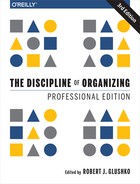4.5. Key Points in Chapter Four
Information retrieval is characterized as comparing a description of a user’s needs with descriptions of the resources that might satisfy them. Different property descriptions determine the comparison algorithms and the way in which relevance or similarity of descriptions is determined.
In different contexts, the terms in resource descriptions are called keywords, index terms, attributes, attribute values, elements, data elements, data values, or “the vocabulary,” labels, or tags.
In the library science context of bibliographic description, a descriptor is one of the terms in a carefully designed language that can be assigned to a resource to designate its properties, characteristics, or meaning, or its relationships with other resources.
A bibliographic description of an information resource is most commonly realized as a structured record in a standard format that describes a specific resource.
Metadata is structured description for information resources of any kind, which makes it a superset of bibliographic description.
(See §4.2.2.2, “Metadata”)
A relational database schema is designed to restrict resource descriptions to be simple and completely regular sets of attribute-value pairs.
(See §4.2.2.2, “Metadata”)
The Standard Generalized Markup Language (SGML) introduced the Document Type Definition (DTD) for describing the structure and content elements in hierarchical document models. SGML was largely superseded by the eXtensible Markup Language (XML).
(See §4.2.2.2, “Metadata”)
The Resource Description Framework (RDF) is a language for making computer-processable statements about web resources that is the foundation for the vision of the Semantic Web.
RDF can be used for bibliographic description, and some libraries are exploring whether RDF transformations of their legacy bibliographic records can be exposed and integrated with resource descriptions on the open web.
An aggregation is a set of information objects that, when considered together, compose another named information object.
Resource description is not an end in itself. Its many purposes are all means for enabling and using an organizing system for some collection of resources.
(See §4.2.3, “Frameworks for Resource Description” final paragraph.)
The dominant historical view treats resource descriptions as a package of statements, an alternate framework focuses on each individual description or assertion about a single resource.
Design of the description vocabulary should focus on the user of the descriptions. Svenonius proposes five principles for a description vocabulary: user convenience, representation, sufficiency and necessity, standardization, and integration.
The process of describing resources involves several interdependent and iterative steps, including determining scope, focus and purposes, identifying resource properties, designing the description vocabulary, designing the description form and implementation, and creating and evaluating the descriptions.
(See §4.3, “The Process of Describing Resources” and Figure 4.3, “The Process of Describing Resources.”)
A collection of resource descriptions is vastly more useful when every resource is described using common description elements or terms that apply to every resource; this specification is most often called a schema or model.
XML schemas are often used to define web forms that capture resource instances, and are also used to describe the interfaces to web services and other computational resources.
When the task of resource description is standardized, the work can be distributed among many describers whose results are shared. This is the principle on which centralized bibliographic description has been based for a century.
The Functional Requirements for Bibliographic Records (FRBR) presents four purposes that apply generically: Finding, Identifying, Selecting, and Obtaining resources.
(See §4.3.2.3, “Resource Description to Support Interactions”)
The variety and functions of the interactions with digital resources depends on the richness of their structural, semantic, and format description.
(See §4.3.2.3, “Resource Description to Support Interactions”)
Any particular resource might need many resource descriptions, all of which relate to different properties, depending on the interactions that need to be supported and the context in which they take place.
Two important dimensions for understanding and contrasting resource properties are whether the properties are intrinsically or extrinsically associated with the resource, and whether the properties are static or dynamic.
Contextual properties are those related to the situation or context in which a resource is described. Dey defines context as “any information that characterizes a situation related to the interactions between users, applications, and the surrounding environment.”
Recent advances in computing technology and data science techniques are making it possible to discover or create resource properties that are called “latent” because they are inferred rather than observed.
(See the sidebar, Latent Feature Creation and Netflix Recommendations)
A controlled vocabulary is a fixed or closed set of description terms in some domain with precise definitions that is used instead of the vocabulary that people would otherwise use. A controlled vocabulary reduces synonymy and homoynmy.
Professionally created resource descriptions, author or user created descriptions, and computational or automated descriptions each have strengths and limitations that impose tradeoffs.
The most commonly used criteria for evaluating resource descriptions are accuracy, completeness, and consistency. Other typical criteria are timeliness, interoperability, and usability.
Sensors that assign resource descriptors can create a fuller and more accurate picture of the world, but they require more processing power to collect the necessary information and render it into a meaningful form.
